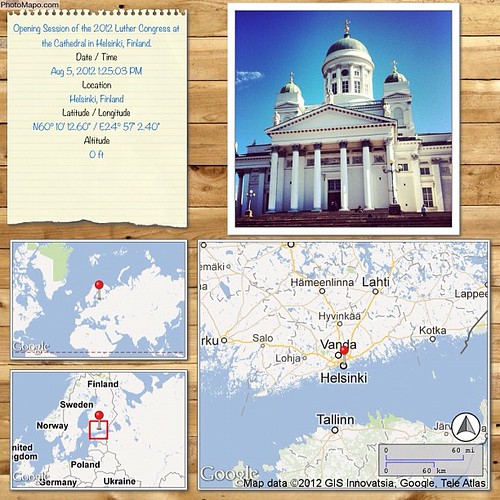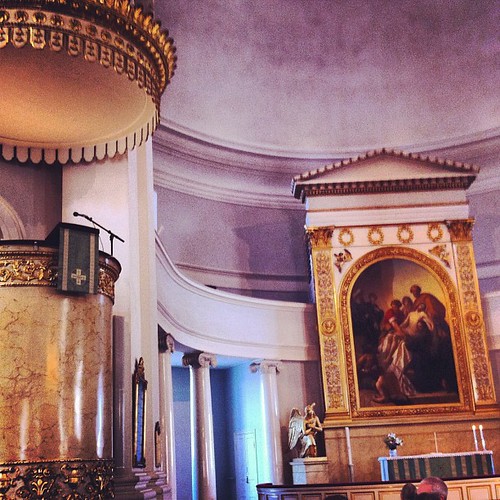Today in Helsinki, Finland, the 12th International Congress for Luther Research began at the Helsinki Lutheran Cathedral. The theme of the 12th Congress is “Luther as Teacher and Reformer of the University,” and will meet in Helsinki from 5th through the 10th of August 2012. The International Congress for Luther Research first met in 1956, and now meets every five years. In 2017, the International Congress for Luther Research plans to meet in Wittenberg, Germany.
Dr. Albert Collver (LCMS) and Dr. Roland Ziegler (CTSFW) Pictured Outside the Cathedral Crypt
Of the approximately 180 Luther and Reformation scholars registered for the conference, by my count (based upon the registration list) 15 are from the LCMS. Both LCMS seminaries are well represented with a combined total of ten professors attending, including: Dr. Gerhard Bode, Dr. Timothy Dost, Dr. Erik Hermann, Dr. Robert Kolb, Dr. Naomichi Masaki, Professor John Pless, Dr. Robert Rosin, Dr. Paul Robinson, Dr. William Schumacher, Dr. Roland Zeigler. Other LCMS attendees include, Dr. Albert Collver, LCMS Director of Church Relations - Assistant to the President, Rev. Jason Lane, Dr. David Lumpp, Rev. Jonathan Mumme (LCMS Missionary / Professor at Westfield House), Dr. Anthony Steinbronn. This evening I personally saw about half of those from the LCMS who registered. Several of the LCMS participants are making sectional presentations.
Dr. Scott Hendrix, the well known Reformation and Luther scholar from Princeton, opened the International Congress for Luther Research with an address. His opening address was followed by Bishop Emeritus Eero Huovinen, who presented “Doctor communes? The ecumenical significance of Martin Luther’s theology.” His lecture concluded with the following, “In summary, may I dare to contend that Martin Luther, in his Catechisms and his writings on Holy Communion, speaks as doctor communis, not attempting to develop new doctrine but rather striving to express and interpret the common faith of the undivided Christendom. Thus his writings still bear ecumenical fruit.” Indeed, Dr. Luther did not invent new doctrine and his teaching especially as confessed in the Small and Large Catechisms and in the Augsburg Confession is that of the catholic Church through the ages.
After the opening address and lecture, a reception was held in the Cathedral’s Crypt. Tomorrow begins the first full day of the International Congress for Luther Research. Looking forward to several days of stimulating papers and discussion on Martin Luther. A few pictures from the Cathedral are provided below.
The Cathedral’s chancel.
The organ in the Cathedral.
A statue of Martin Luther in the Cathedral.
The entrance to the Crypt.
The Lutheran Cathedral in Helsinki was consecrated in 1852 and named the Church of St. Nicholas. The church was modeled after the Kazan Cathedral in St Petersburg, Russia. After Finland obtained independence from Russian in 1917, the Cathedral became known as the “Great Church.” In 1959, it was named the Helsinki Cathedral and is one of ten cathedrals of the Evangelical Lutheran Church of Finland.
-- Posted by Rev. Dr. Albert B. Collver, Director of Church Relations on 5 August 2012.









No comments:
Post a Comment